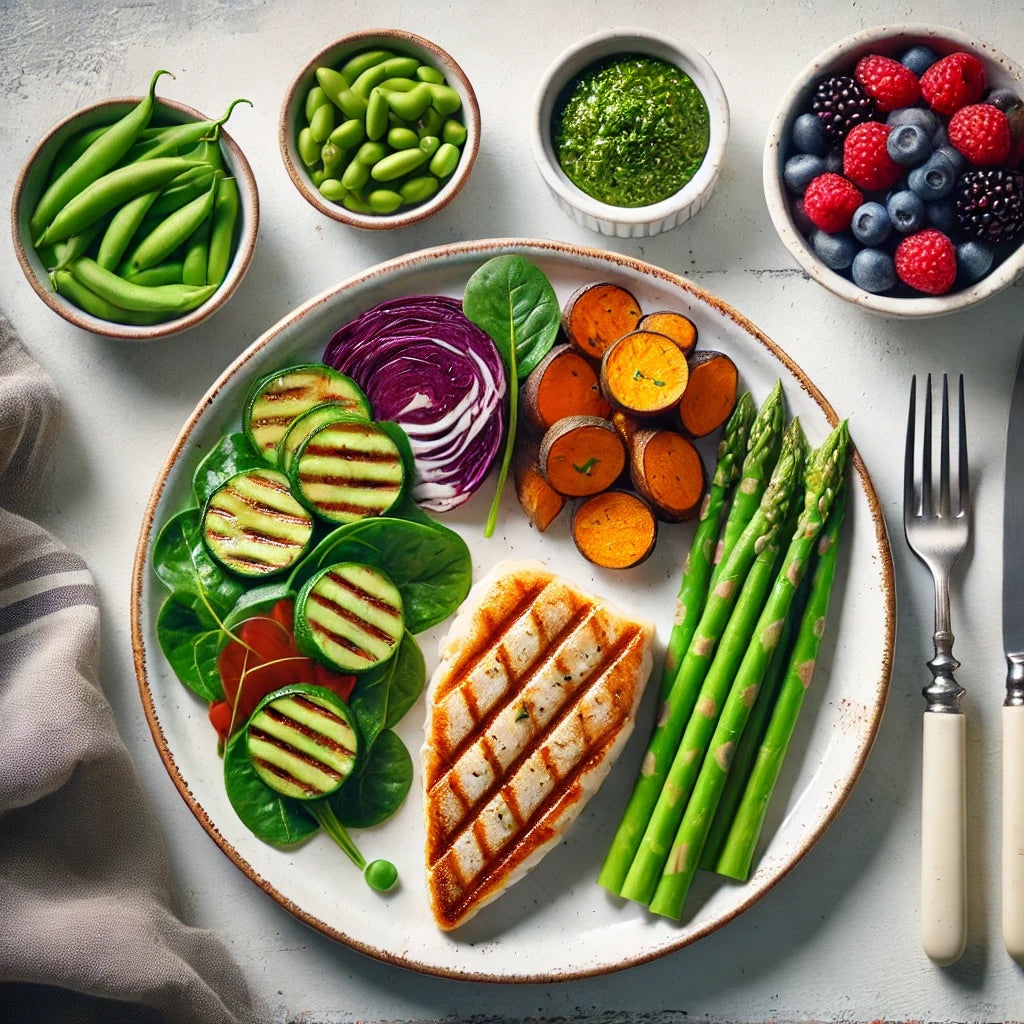
DASH Diet Explained: Benefits, Foods, and Tips to Lower Blood Pressure
Share
The DASH diet, short for Dietary Approaches to Stop Hypertension, is a dietary plan aimed at preventing and managing high blood pressure (hypertension). Developed by the National Institutes of Health (NIH) in the 1990s, the DASH diet emphasizes nutrient-rich foods while minimizing the intake of sodium, added sugars, and saturated fats. Its primary goal is to promote heart health by encouraging a balanced intake of potassium, calcium, and magnesium, which are crucial for maintaining healthy blood pressure levels.

The Core Principle of the DASH Diet
The DASH diet is based on a straightforward principle: consume more whole plant based foods and fewer processed foods. It prioritizes foods that are naturally high in nutrients, full of fiber and low in unhealthy fats. This diet recommends:
- Fruits and Vegetables: Aim for 4-5 servings of each daily.
- Whole Grains: Incorporate 6-8 servings per day.
- Lean Proteins: Include beans, poultry, fish, and nuts, while limiting or eliminating red meat and full-fat dairy.
- Healthy Fats: Choose unsaturated fats from sources like olive oil and avocados.
- Low Sodium: Reduce sodium intake to less than 2,300 mg per day, with a target of 1,500 mg for even more benefits.
Key Health Benefits of the DASH Diet
The DASH diet is known for its extensive health benefits, which go beyond just lowering blood pressure. Some of the primary benefits include:
1. Lowering Blood Pressure
Research has shown that following the DASH diet can significantly reduce blood pressure, particularly in individuals with hypertension.
2. Promoting Heart Health
With its focus on heart-healthy foods, the DASH diet may lower the risk of heart disease and stroke.
3. Weight Management
The emphasis on whole foods and portion control helps with weight loss and maintaining a healthy weight.
4. Reduced Risk of Chronic Diseases
By improving diet quality, the DASH diet can also help reduce the risk of developing type 2 diabetes, certain cancers, and osteoporosis.
How to Follow the DASH Diet: Practical Tips
Following the DASH diet involves incorporating its principles into your daily eating habits. Here’s how you can start:
1. Plan Your Meals
- Build your meals around fruits, vegetables, whole grains, and lean proteins.
- Use a weekly meal planner to organize your shopping list and meals.
2. Read Nutrition Labels
- Check for sodium content in packaged foods.
- Choose items labeled “low sodium” or “no added salt” to reduce overall salt intake.
3. Incorporate Variety
- Try different fruits, vegetables, and grains to keep meals exciting and nutritious.
4. Cook at Home
- Home-cooked meals allow for better control over ingredients, especially sodium levels.
5. Stay Hydrated
- Drink plenty of water throughout the day and limit sugary beverages.

Foods to Include on the DASH Diet
Here’s a detailed list of DASH diet-approved foods to help guide your meal planning:
Fruits
- Apples, Bananas, All Berries, Oranges, Pears, Melons.
Vegetables
- Spinach, Broccoli, Carrots, Tomatoes, Bell Peppers, Sweet Potatoes, Kale, Cabbage, Brussel Sprouts, Asparagus, Zuchhini, squash and so much more.
Whole Grains
- Brown Rice, Quinoa, Whole Grain Bread, Oats, Barley, Whole Grain Pasta (limit pasta).
Lean Proteins
- Skinless Poultry (Chicken or Turkey), Fish (Salmon, Mackerel, Sardines), Beans (Lentils, Chickpeas, Black Beans), Nuts and Seeds (Almonds, Walnuts, Chia and Pumpkin Seeds).
Dairy
- Low-fat or Fat-free Yogurt, Low-fat Milk or Plant-based Milk Alternatives (Almond, Soy).
Healthy Fats
- Olive Oil, Avocado, Nuts (in moderation).
Herbs and Spices
- Fresh Herbs (Basil, Cilantro, Parsley), Spices (Cinnamon, Cumin, Garlic Powder) for flavoring instead of salt.
Foods to Limit on the DASH Diet
To fully benefit from the DASH diet, certain foods should be limited or avoided:
- High-Sodium Foods: Processed meats, canned soups, frozen dinners.
- Sugary Beverages and Sweets: Sodas, candy, and baked goods with high sugar content.
- Full-Fat Dairy: Replace with low-fat or plant-based alternatives.
- Red Meat: Limit consumption and opt for leaner protein sources like fish and poultry.

DASH Diet Sample Meal Plan
Here’s a sample day on the DASH diet to give you a better idea of what a day’s worth of eating looks like:
Breakfast
- Oatmeal topped with berries and a sprinkle of chia seeds.
- Low-fat yogurt with berries and walnuts.
Lunch
- Grilled chicken salad with mixed greens, avocado, cherry tomatoes, and a homemade balsamic vinaigrette.
Dinner
- Baked salmon with a side of quinoa and steamed broccoli.
- Finish with a piece of pharmer bread and a small bowl of fresh fruit.
Putting it into Practice
The DASH diet is a flexible and balanced eating plan that emphasizes plant forward nutrient-rich foods to support heart health and lower blood pressure. By incorporating a variety of fruits, vegetables, whole grains, and lean proteins while minimizing sodium intake, individuals can experience improved health outcomes. Whether you’re looking to manage hypertension or simply adopt a healthier lifestyle, the DASH diet offers a sustainable and effective approach to healthy eating.
__________________________________________________________________________
FAQs About the DASH Diet
1. How long does it take for the DASH diet to lower blood pressure?
Studies show results can occur within 2 weeks, depending on the individual's adherence.
2. Can the DASH diet help with weight loss?
Yes, the DASH diet encourages portion control and whole foods, aiding in healthy weight management.
3. What are the main foods to avoid on the DASH diet?
Avoid high-sodium foods, added sugars, and saturated fats like full-fat dairy and red meat.
4. Is the DASH diet suitable for diabetics?
Yes, the DASH diet can help regulate blood sugar levels and is considered beneficial for diabetics.
5. Can I follow the DASH diet if I'm vegetarian?
Absolutely! The DASH diet includes many plant-based proteins, such as beans, nuts, seeds, and legumes, making it adaptable for vegetarians.
